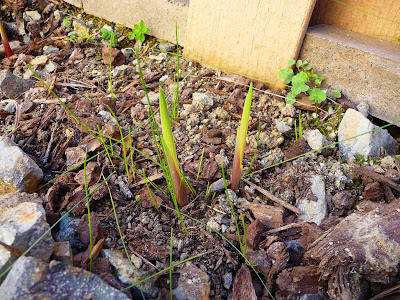Well, it turns out there are a lot of great resources online that tell you how to build your own worm bin! Here are the websites that I got my worm bin instructions from:
"Cheap and Easy Worm Bin" - Lots of good pictures
VirginiaTech "Composting Your Organic Kitchen Waste with Worms"
"The Down and Dirty on Worm Composting" by Liz Pevytoe - A pdf file that is a short E-Book on the subject. Very thorough!
Here is what I did to build my own worm bin for $10!
First I went to Wal-Mart and purchased two 10-gallon Sterilite plastic containers ($5 each). Apparently worms like the dark, so make sure you get bins that are not transparent, but opaque like these. Transparent bins can also make it hot for the worms, which could kill them! One bin will serve as the actual worm bin, and the other will serve as a catch tray for the "worm tea."
I then followed the instructions and took a 1/8" drill bit and drilled holes along the top of the bin and on the lid of the bin. These act as air holes for the little wormies so they don't suffocate. It is also important to keep these holes small so that it prevents fruit flies from getting into your bin and eat your yummy rotting kitchen waste!
I also drilled some 1/8" and 1/4" holes at the bottom of the bin.
This serves two purposes. (1) It provides drainage for any excess liquid in the bin, including worm tea, which is just a nice name of worm pee. Apparently the worm tea also is a great fertilizer for your plants, and an effective organic pest repellent when you spray it on your plants. Bye-bye aphids! (2) When this worm bin gets full, I can stack it onto a new bin with scraps in it, and the holes allow the worms to travel between this bin and the new bin.
I then filled the bin with some bedding, which basically was paper bits from my shredder that I soaked in water. Make sure you squeeze out any excess water. The bedding should be wet like a damp sponge, but should not put out more than a drop or two of water when squeezed.
In the second bin, which has no holes in it, I placed four miniature pots, one in each corner, to act as risers for the worm bin. You can use bricks, plastic cups, etc... This will give the worm bin plenty of room to drain out while also catching the valuable worm tea.
I then stacked it all together and it was ready for the worms!
 The next morning we went to the Vista Farmer's Market to visit Rubi, of "Rubi's Reds." She is there every week and sells worm castings and red wrigglers. She had her worms sitting in a bin similar to mine, and when I made my purchase, she grabbed a plastic bag and shoveled a couple piles of wormy goodness into the bag. She showed me pics or her worm farm, where she raises tens of thousands of worms in piles of dirt on her land. She also showed me some of her plants that she's been feeding worm castings to, and all I could think was, "Hey, you don't have to sell me on the idea. I'm sold!" I also asked her a number of questions based on the reading I had done, and she told me not to worry about all the things I read. Just dump the worms in, put the lid on, and they'd take care of the rest. It was that simple. I was so excited to take these little guys home!
The next morning we went to the Vista Farmer's Market to visit Rubi, of "Rubi's Reds." She is there every week and sells worm castings and red wrigglers. She had her worms sitting in a bin similar to mine, and when I made my purchase, she grabbed a plastic bag and shoveled a couple piles of wormy goodness into the bag. She showed me pics or her worm farm, where she raises tens of thousands of worms in piles of dirt on her land. She also showed me some of her plants that she's been feeding worm castings to, and all I could think was, "Hey, you don't have to sell me on the idea. I'm sold!" I also asked her a number of questions based on the reading I had done, and she told me not to worry about all the things I read. Just dump the worms in, put the lid on, and they'd take care of the rest. It was that simple. I was so excited to take these little guys home!Back at la casa, I opened up my bin and dumped the contents of the bag into the bin.
At first, all I could see was the dirt that they came in, but looking a little closer, I was able to spot the little guys. They burrow pretty quickly and are good at hiding, so I'm not really sure how many worms I have in there. I'm sure there are more than I realize! There were even baby worms that you had to really concentrate to find.
So we'll see how it goes. I gave them a little bit of a banana peel yesterday, and I can't help but go check on them everyday (this is my third day since I brought them home). Everyone says be patient though, so maybe I'll let them be for another week, and hopefully I'll see some progress soon!




























